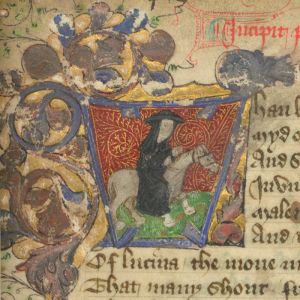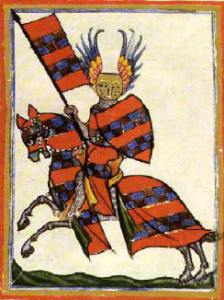 Travel in medieval times was a challenge to say the least. In and between rural areas, there might not be more than a narrow, beaten earth path. Overly wet or snowy weather could make such roads impassable for long stretches of time. Bandits, weather, and wild animals all added to the hazards of the road. Though main trade routes were larger and better maintained (better guarded as well) they were far from comfortable. Wagon tires were primitive, made from flexible sapling wood, and transporting anything heavy was fraught with difficulties. When possible, pack animals were used by merchants who needed to get their goods from village to village. Travel by sea was no safer than travel by foot or beast, and the sea claimed many a historic figure, including the son of King Henry I.
Travel in medieval times was a challenge to say the least. In and between rural areas, there might not be more than a narrow, beaten earth path. Overly wet or snowy weather could make such roads impassable for long stretches of time. Bandits, weather, and wild animals all added to the hazards of the road. Though main trade routes were larger and better maintained (better guarded as well) they were far from comfortable. Wagon tires were primitive, made from flexible sapling wood, and transporting anything heavy was fraught with difficulties. When possible, pack animals were used by merchants who needed to get their goods from village to village. Travel by sea was no safer than travel by foot or beast, and the sea claimed many a historic figure, including the son of King Henry I.
 However, history shows that in spite of the dangers and discomfort of travel, it remained an important part of medieval life. Travel was just about the only way to get news from one place to another. Couriers might be entrusted with critical and private messages, while those meant to be disseminated among large populations were given out by public proclamation, or announced through church sermons. Celebratory events of historic significance, and sometimes propaganda, were immortalized in songs and poems, which spread quickly and continued to live on in people’s memories. Since most could not read or write, verbal person-to-person communication was the most effective. Some forms of communication were visual as well. Certain types of clothing bore special meaning that would have been understood by those who came in contact with the wearer. Banners, coats of arms, specific patterns of color, and badges were also visual forms of communication.
However, history shows that in spite of the dangers and discomfort of travel, it remained an important part of medieval life. Travel was just about the only way to get news from one place to another. Couriers might be entrusted with critical and private messages, while those meant to be disseminated among large populations were given out by public proclamation, or announced through church sermons. Celebratory events of historic significance, and sometimes propaganda, were immortalized in songs and poems, which spread quickly and continued to live on in people’s memories. Since most could not read or write, verbal person-to-person communication was the most effective. Some forms of communication were visual as well. Certain types of clothing bore special meaning that would have been understood by those who came in contact with the wearer. Banners, coats of arms, specific patterns of color, and badges were also visual forms of communication.
 But there was another important reason to travel, aside from the need to spread news, buy and sell wares, or the desire to see new places and people. That was a spiritual one. Pilgrimages to holy sites, whether small local shrines, to Rome, or to the ultimate site of Jerusalem, were encouraged by the Church. The most important pilgrimages were those made to places that were directly connected with the birth, life, crucifixion, or resurrection of Jesus. Christians would travel in large groups to such destinations for greater safety on the road. When such an arduous journey was impossible, one found closer pilgrimage sites associated with martyrs, the saints, important relics, or visions of Mary. It was believed that traveling to such places was an act of penance that might lead to the forgiveness of sins, and brought about a greater chance of going to heaven. Shrines were thought to be places of power, where supernatural intervention could occur for those most desperately in need of help. Some shrines were known for specific powers, like curing sickness. Pilgrims who made it to sites of significance collected or wore badges as a sort of souvenir, and proof that they had made a significant spiritual journey.
But there was another important reason to travel, aside from the need to spread news, buy and sell wares, or the desire to see new places and people. That was a spiritual one. Pilgrimages to holy sites, whether small local shrines, to Rome, or to the ultimate site of Jerusalem, were encouraged by the Church. The most important pilgrimages were those made to places that were directly connected with the birth, life, crucifixion, or resurrection of Jesus. Christians would travel in large groups to such destinations for greater safety on the road. When such an arduous journey was impossible, one found closer pilgrimage sites associated with martyrs, the saints, important relics, or visions of Mary. It was believed that traveling to such places was an act of penance that might lead to the forgiveness of sins, and brought about a greater chance of going to heaven. Shrines were thought to be places of power, where supernatural intervention could occur for those most desperately in need of help. Some shrines were known for specific powers, like curing sickness. Pilgrims who made it to sites of significance collected or wore badges as a sort of souvenir, and proof that they had made a significant spiritual journey.

A medieval souvenir pilgrim badge from Amiens Cathedral
Reblogged this on Teila's Blog and commented:
Love this! Medieval travel! #gamedesign #writing
LikeLiked by 1 person
Reblogged this on Chris The Story Reading Ape's Blog.
LikeLiked by 1 person
Just today I was driving back from my quick trip to Target, in horrible wind and rain, and thinking to myself, “Isn’t it great that I don’t have to haul a cart and mule up these muddy hills?”
It is. It’s really great.
LikeLiked by 1 person
Definitely! And back then, after hauling stuff through the mud with a stinky, wet mule, there would be no central heat to come home to. No hot shower, or washer and dryer to take care of the wet clothes. It really had to be miserable.
LikeLiked by 2 people
Reblogged this on Kate McClelland.
LikeLiked by 1 person